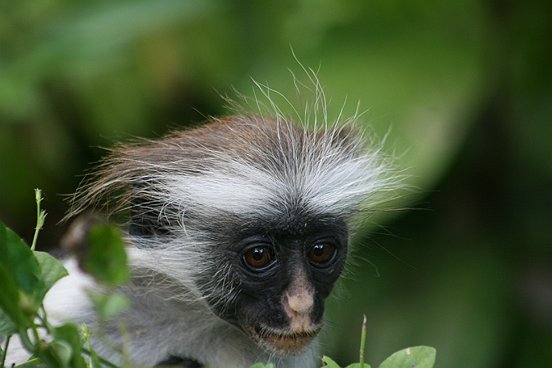Sunday, January 16, 2011
This summer, we’ll be offering a new trip July 2-13 to Tanzania. We’ll be visiting the chimps of Gombe, made famous by the amazing work of Jane Goodall. We’ll also see the incredible wildlife in Selous, the oldest and largest game park in Africa. And at the end of this trip, there is a special treat, a visit to Zanzibar, the famed Spice Island, where we plan to spend a couple of days relaxing, with opportunities to visit the Jozani Forest to see the endemic Red Colobus Monkeys, plus ample time to go snorkeling in the Indian Ocean.
The red colobus are Old World monkeys closely related to the black-and-white colobus monkeys and some species are often found in groups with the Blue Monkey. Most are restricted to humid forests, but the Zanzibar Red Colobus prefers coastal thickets and scrub. Red colobus monkeys are primarily arboreal and are highly sensitive to hunting and habitat destruction, and have been referred to as probably the most threatened taxonomic group of primates in Africa. Consequently, this species is considered Endangered or Critically Endangered.
Groups often establish a dominant hierarchy determined by aggressive behavior. Food, grooming, and sexual partners are distributed amongst higher ranking individuals initially, followed by lower ranking individuals. Research has shown that attacks on red colobus monkeys by chimpanzees indicate that chimpanzee predation may be a major selection factor upon red colobus populations. When under attack, the red colobus males congregate to defend their group while the females gather their infants and try to escape. Larger groups of red colobus have an increased likelihood of attracting chimpanzees, however they also tend to have more defending males which makes it harder for chimpanzees to successfully hunt. Furthermore, while under attack, male colobus shout an alarm call that lets others know if there are chimpanzees or other predators in the area. The frequency of these shouts are increased with the number of females and infants in the group as a way to spread the news of an expected attack.
For every participant on this trip a donation will be made to the Jane Goodall Institute. These funds will help support the valuable work of the Jane Goodall Institute and their Roots and Shoots environmental education outreach programs.




